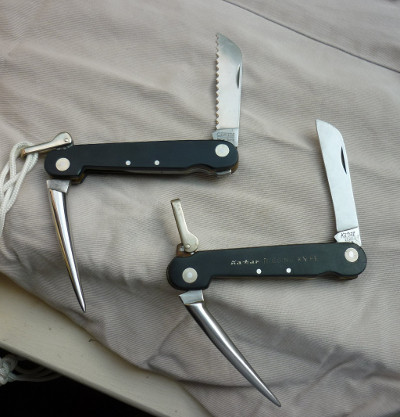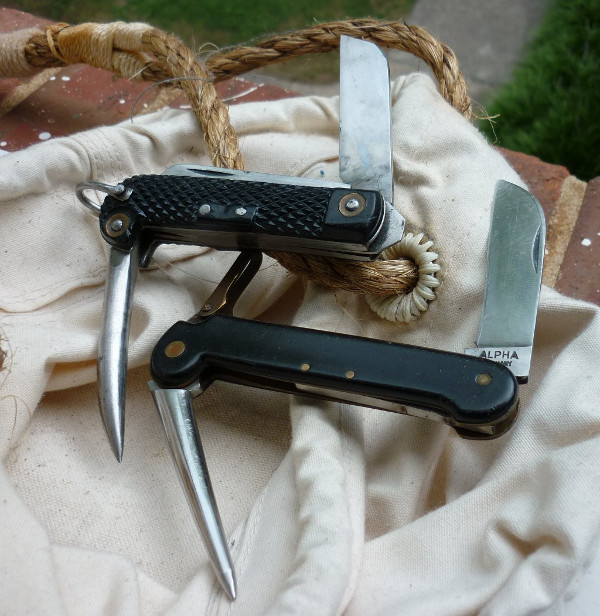 |
For safety and convenience, a sailor should carry a knife. Most sailors carry a pocket or sheath knife, with a backup close at hand (but not on a bracket on the binnacle, as the magnetic steel will play havoc with the compass). Back in the days of sailing ships, sailors used straight edged, heavy backed knives to cut rope - they laid the rope on deck and pounded the blade through with a mallet or belaying pin. Today, sailors carry pocket knives or folding sheath knives with rounded ends, the better not to accidentally puncture a sail (or sailor). Most have straight-edged blades, but some have serrated edges, which work well on rope. In addition to one or more blades, many sailor's knives incorporate a marlinspike. Ones with locking spikes are known as rigger's knives, while the ones with non-locking spikes are known as yachtsman's knives. Shackle wrenches are a welcome addition found on some sailor's knives . The big American cutlers Camillus, Buck, Schrade and Case made rigger's knives until fairly recently, and imported knock-offs of these "American-Style" knives are still being made - sadly, not of much quality. The American made ones can still be found on the used market, but the prices are escalating rapidly.
Camillus was the last U.S. maker of riggers and by far the largest supplier to the market. In fact, they built Case's for them from 1979 until Case dropped it from their line on Camillus' bankruptcy in 2007. Camillus also supplied Kabar and other American cutlers with knives to market under their own brands. The Camillus knife was a real tank, absolutely solid and next to impossible to break.
 |
The British had their own pattern of rigger that derived from the pattern 6353 adopted by the British military in 1905. It was the basis for a NATO pattern that was made by the millions by Sheffield and Belgian cutlers (and some of the American cutlers as well). These can be picked up at reasonable prices. The NATO pattern was a real multi-tool, with blade, spike, shackle wrench and screwdriver. Interestingly, I have never seen a German-made rigger of the NATO pattern. German riggers tended to make the American pattern.
Another sailor's pattern is commonly known as the "Coast Guard" knife. Camillus again was the big supplier, turning out several million of them during World War II as standard issue to sailors and for use in lifeboat survival kits. Camillus continued to produce them right up until they closed the factory. I was fortunate in being able to buy two of the last ones off the line, still in their factory packaging. This pattern goes way back. Bernard Levine's Guide to Knives and Their Values includes one from 1816. The can opener on the Camillus is the only real design innovation on these knives in the last 200 years. Utica Cutlery of Utica, NY is the last producer standing for these classic knives. The Uticas are not widely distributed but can be purchased from Knife Center. Similar to the Coast Guard pattern is a small single-bladed coping knife, 3 1/4 inches in length, known as a Navy knife. Like the other patterns, these were made in huge quantities during the war. I carry one often. It is easily pocketable and plenty enough knife to handle most rope found on sailboats.
As far as current production rope knives - Meyerchin makes quality riggers in Asia. The older ones were made in Japan, but evidently the new production is all Chinese. I have heard that they have maintained their standards. Rough Rider makes a Case/Camillus knockoff, but this Chinese knife has a reputation for a weak lock, leading to unpleasant fold-up accidents. The German cutler Mercator made a rigger to the American pattern, but the one I got evidently slipped out of the factory in unfinished condition - or perhaps it was shipped that way on purpose. It is no longer cataloged, but their Otter Messer Coast Guard style knife is still available. French maker Therias et L Econome sells a top quality Coast Guard style knife. Some of the Sheffield makers are still shipping NATO style riggers, but be careful here. As the old European and American cutlers have gone bankrupt, makers of cheap, low-quality Chinese made knives have bought up the names to stamp on their product. The Chinese know how to make good knives, as the Myerchins prove, but they are also willing to make poor-quality junk, if that is what they are asked for.
Boye Knives makes beautiful modern yachtsman's knives that cost a small fortune but, according to well-heeled friends who own them, are worth every cent.
In addition to my pocket knife, I like to have a big fixed-blade knife on the boat for really heavy work. Condor Tool and Knife of Santa Ana, El Salvador makes some of the toughest knives I have ever seen. They're crudely built, but they will take a beating and keep cutting. One of them stays just inside the companionway of my boat.
One more picture: